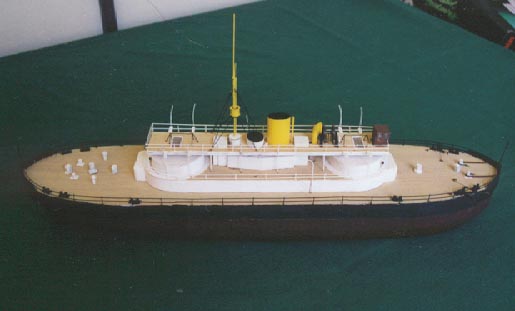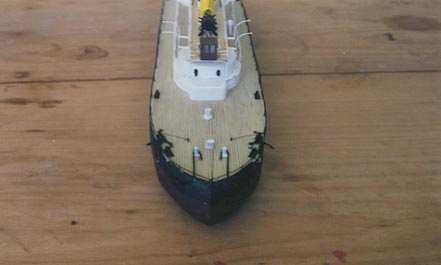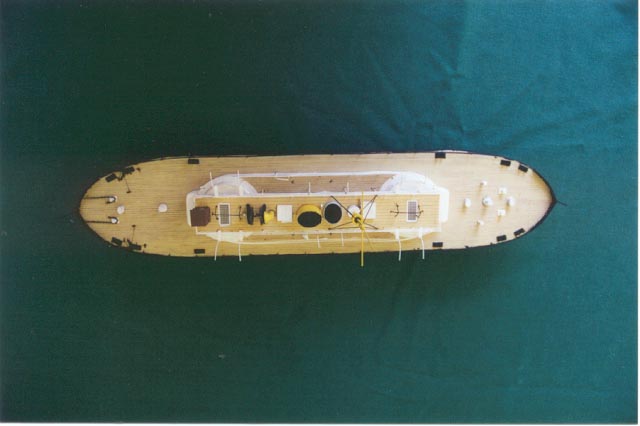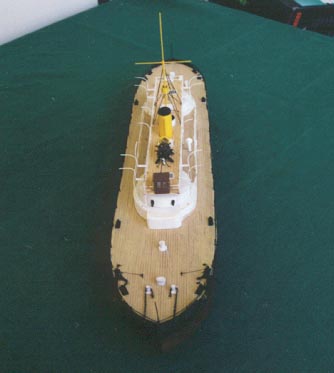|
HMVS
Cerberus
by
Roger Marsh
|

|
|
HMVS
Cerberus
|

HyperScale is proudly sponsored by
Squadron.com
I have enjoyed modelling various subjects in various scale for
about nine years now, having picked up the hobby again after having a
long break during my teenage years. Initially I returned to my initial
passion of aircraft, but as my skills increased, I wanted to try
different things.
Most of my modelling efforts are now centred around model railways,
but I still do dabble in static models, particularly Korean War
subjects (because my father is a veteran of that conflict), and early
Australian warships of the colonial era. As there are few kits of
Australian warships available apart from a few modern vessels, this
means that scratch-building is a must, and so begins the story of the
construction of HMVS (Her Majesty's Victorian Ship) Cerberus.
 I
became interested in the Cerberus for two reasons. First of all
because of its broad, box like hull, making it a simpler subject for
modelling than other vessels with far more attractive lines. Second,
my father had been a parade ground 'bull' at the current Cerberus, and
had told me that the shore depot had inherited the name from an old
monitor that is now a breakwater. I
became interested in the Cerberus for two reasons. First of all
because of its broad, box like hull, making it a simpler subject for
modelling than other vessels with far more attractive lines. Second,
my father had been a parade ground 'bull' at the current Cerberus, and
had told me that the shore depot had inherited the name from an old
monitor that is now a breakwater.
So with the encouragement of my wife (who aids and abets me at
every turn) I began to research this vessel. Some small drawings were
found in a book called "Watchdogs Infernal and Imperial: The
Warships Cerberus" (long out of print, found in the Social
sciences library of the University of Queensland) from which I made my
own simple drawings. These were later checked against more detailed
plans to resolve some areas of uncertainty. Plans of some sort are a
must when scratch-building, the less 'guesstimation' involved the
better.
Cerberus belongs to a class of harbour defence monitors constructed
in the 1860s, amongst the first warships constructed in Britain
without sails. As an apparent jibe against their ugliness compared to
sailing vessels, the Lords of the Admiralty gave these ships names
derived from monsters in Greek mythology (e.g. Gorgon, Cyclops),
Cerberus being the three headed dog that guards the gates of Hades.
They were not built for beauty, but to be able to belt the living
daylights out of other ships, and the main armament of four 10 inch
guns was quite substantial for the period. The Cerberus was purchased
by the Navy of the Colony of Victoria, and eventually passed into the
possession of the Royal Australian Navy.
The model is entirely scratchbuilt, apart the ventilation cowls,
the ships wheels and the anchors. The latter are both being metal
castings by Artesenia Latina whilst the former were dug out of the
spares box (or as some have said, the box of solutions awaiting a
problem). It is built to a scale of 2mm to the foot, a strange scale
for ship modelling, but one well know to railway modellers. I should
have thought this through a bit more, as this meant that commercially
available fittings were very hard to come by.

The hull was built up using balsa, with a central spine carrying
the ribs to make up a frame work for the ship. This frame was then
covered in light balsa sheet, which was in turn covered in light card
and then painted with grey Tamiya acrylic. The deck was laid out with
more balsa, with a central hole cut for the superstructure, which was
then made out of plasticard. The decks have been scribed to represent
the planking. Gun barrels were made out of two pieces of aluminium
tube each, one slightly smaller than the other so that the taper of
the barrel could be depicted. This however is invisible, so it makes
me wonder why I bothered! Bollards and other fittings were made out of
plastic rod, and the mast and other long thin things like the boat
davits were made out of brass wire. I have yet to add any ship's
boats, and I may never do so. The really crazy part is the handrails,
and these were fabricated from the finest plastic rod I could find,
and then glued with styrene cement to the plastic uprights. They were
heated a bent to the shpe they were meant to follow. It was a bit of
an experiment, as I was wanting to see if I could avoid soldering, or
the more hostile forms of cyano glue. I may yet replace these with
brass wire, as they come loose if the model is handled even a little
carelessly.
Painting follows the conventional pattern of the late 19th century
British Empire warships, with red below water line, black above, white
superstructure and a buff yellow for mast and funnels. This paint
scheme is more typical than exact, as my information was a bit limited
at this point, and I did not have the time or inclination to nail it
down exactly.
 This
model was a lot of fun to build, taking slightly less than a year with
substantial breaks during that time. This
model was a lot of fun to build, taking slightly less than a year with
substantial breaks during that time.
It improved my mixed media modelling no end, though it also
prompted a friend of mine to give me a hat with the lettering
"Fine Scale Freak" on the front!
I would like to thank a few people for their help in this model.
First, Ian MacFarlane whose website dedicated to saving the original
vessel provided much useful information ( http://kitty.netconnect.com.au/~ianmac/cerberus.html
). It is a real shame that such an historic vessel is laying out there
rusting into oblivion. From that website a waterline card model of the
Cerberus (designed by another person I want to thank, one David
Hathaway) can be downloaded for free, and by the looks of it builds up
into a very nice model indeed. So if you get the urge to build
something without the smell of plastic weld in your nostrils this
could be just the thing you need! If you want to see some pictures of
the model during construction then look at http://kitty.netconnect.com.au/~ianmac/marsh.html
.
I would also like to thank Tony Collins for his help and
advice during construction, and my wife who encouraged me to have a go
in the first place.
Model, Images and Text Copyright © 2001 by
Roger Marsh
Page Created 22 May, 2001
Last Updated 04 June, 2007
Back to HyperScale Main
Page
Back to Features
Index
|
Home
| What's New |
Features |
Gallery |
Reviews |
Reference |
Forum |
Search